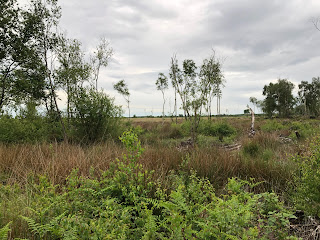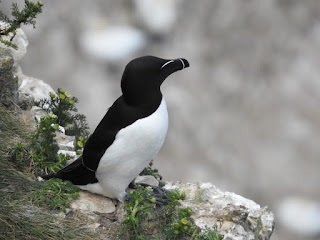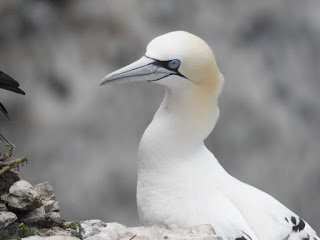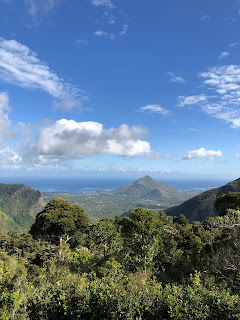A Big Day in Nottinghamshire & Yorkshire!
I'd been planning this day for a while. A big trip through Nottinghamshire and Yorkshire to look for some birds I never normally see (namely Puffin, Turtle Dove, Razorbill etc.), and maybe even a few lifers. Being on a UK list of 253, getting a lifer that isn't a rarity is a rare thing for me nowadays. The possibility of Woodlark and Honey Buzzard in Sherwood Forest was an exciting prospect. As was the chance of reaching 100 birds in a day, something I've only achieved once before in the UK (101 in Norfolk in January 2019).
However in the walk there, through what was quite probably the strangest habitat I have ever seen - fields of solar panels, old concrete colliery roads, and scrubby trees littering spoil heaps - we managed to find the two birds of the day! About 1km from the car, my dad heard the unmistakeable purring of a Turtle Dove coming from above the path. It was perched on a concrete fence post around a field of solar panels, concealed behind some trees. It flew off, but was soon joined by 2 others and they all gave a close flyby! This is a sound I have only ever heard once before, and I have never stumbled upon Turtle Doves like this before. It is a known breeding site but not in the same 'staked-out' way as somewhere like Frampton Marsh. So the birds were a big surprise.
 |
| Tree Sparrows are actually an unusual bird for me - we saw many at Bempton though |
 |
| Major Oak is around 1000 years old! |
So, on the 4th of June we undertook it. Granted the time of year for a big day list isn't ideal but I always have exams during late April/May and birding from sunrise to sunset isn't conducive to productive revision!
Waking at 05:00 it was just getting light, and the birding began. The first stop was Sherwood Forest and we were birding here before 06:30. The first bird we saw after stopping in the RSPB Budby Common car park on the B6034 was a Tree Pipit singing from an overhead wire - a great start - and a bird we would see many more times on the heath. We set off on a circuitous walk across the heath and back through Sherwood Forest past Major Oak, eager not to miss any heathland or woodland birds as this would be our only chance for some.
Budby Common was busy with birds, and at the crossroads in the centre of the heath we heard our main target. A singing Woodlark. This was my first time hearing this species and what a song! This was my first lifer in months, the last being Eastern Yellow Wagtail at the start of the year. Soon we were watching 2 birds flying round the heath, incredibly unobtrusive had it not been for the song. Continuing with our walk we added some important woodland birds that we would not see again - Nuthatch, Garden Warbler, Coal Tit and Cuckoo were added to the list. Soon it was time to move on, but with 45 species and not a single water bird yet, we were pretty happy with our coverage of this habitat.
On the way to our site for Honey Buzzard, we stopped at Budby Pumping Station on the way past. The potential of this site is really evident. In a short time, we racked up a few water birds, being our first stop in this habitat. We also scoped a Mistle Thrush in the fields west of the flash, which was an important addition we would not find again. The best bird, however, was a Spotted Flycatcher in the trees south of the pumping station itself, just before the green gate to the heath. With several more opportunities for wetland birds later on, and pleased with our unexpected addition of the flycatcher, we moved on.
We arrived at Welbeck Watchpoint at around 9:30 with a few birders already assembled along the roadside. Over the next half hour, we watched lots of hirundines hawking over the water and a fly by female Mandarin was a bonus tick, but it was clear that very few raptors were flying today. One birder had seen Common Buzzard that morning but that was it - no sign of Honey Buzzard or Goshawk. We left, eager not to lose time on an unlikely bird. This turned out to be a wise move as neither were seen that day.
The long drive to Hornsea added only Swallow to the day list and we arrived at around 11:30 with a day list of 65. The reasonably warm morning in Sherwood had been replaced with a bitterly cold northerly wind sweeping in off the mere. We walked along the footpath on the south side of the lake, because Kirkholme Point remained closed. The conditions were not good for viewing the ducks on the far side of the lake but we were pleased to add Wigeon - not an easy bird in June. Cetti's warbler, Sand Martin, Hobby, Cormorant and a few others were also added. However, we were slightly disappointed by missing out on Red-Crested Pochard, Pochard, Little Gull and Grasshopper Warbler, all of which had been present in the previous days. Windswept and hungry, we left, feeling that the conditions were not going to improve and it was best to focus our attention elsewhere.
A short drive to Bempton Cliffs and soon we were feasting our eyes on hundreds of auks and other seabirds. This is truly one of my favourite places in Britain. Astonishing for a mainland site. Razorbill, Guillemot, Puffin, Kittiwake, Fulmar and Gannet were all added to the list along with Tree Sparrows. There were more here than I’ve seen in many years. Razorbills were particularly confiding and Gannets gave eye-level flybys past the viewing platforms. Social distancing here was easy and refreshingly well-practiced by all. The Puffins proved the most difficult, and while they were extremely easy to spot flying around and disappearing into burrows, finding one sat on the cliffs proved slightly trickier as always.
We had to tear ourselves away from here to move on to our next site - Flamborough Head - just down the road. A listen for Quail near Buckton drew a blank. We ate lunch on the cliffs by the lighthouse as we watched the sea but, being mid afternoon, very little passage was going on and it was tricky to tell what was moving and what was just flying around the cliffs! Shag was added to the list, as was a singing Rock Pipit.
Knowing that this area wouldn’t add many new birds to the list, we went for a walk to Old Fall with the hope of finding a rarity. Blyth’s Reed and Icterine Warblers, Rosy Starling and Red-Breasted Flycatcher had been found in recent days, all proving to be one day birds. Indeed, at this time of year there are probably just as many rare migrants as common ones. Unfortunately, it wasn’t to be, though Old Fall plantation did have a very ‘rare’ feel about it. Lesser Whitethroat was the only reward for our efforts. The time was now getting on - the lengthy walk from the lighthouse to Old Fall and back (mainly to satisfy my optimism!) had taken a lot more time than expected.
Knowing that this area wouldn’t add many new birds to the list, we went for a walk to Old Fall with the hope of finding a rarity. Blyth’s Reed and Icterine Warblers, Rosy Starling and Red-Breasted Flycatcher had been found in recent days, all proving to be one day birds. Indeed, at this time of year there are probably just as many rare migrants as common ones. Unfortunately, it wasn’t to be, though Old Fall plantation did have a very ‘rare’ feel about it. Lesser Whitethroat was the only reward for our efforts. The time was now getting on - the lengthy walk from the lighthouse to Old Fall and back (mainly to satisfy my optimism!) had taken a lot more time than expected.
We headed off to North Cave, knowing we needed a clean sweep of the birds available to reach 100. We got off to a good start and amongst others Common Tern, Teal, Avocet and Shelduck were added on the scrapes. As was Reed Warbler. North Cave is a site I have visited since I was very young and there always seems to be a new scrape on every visit!
Soon the rain came in and hampered our efforts of picking out the pair of Med Gulls from the busy Black Headed Gull colony. The driving rain made our hopes of Corn Bunting and Red Kite diminish, so we arrived back at the car, soaked, on 92 species with a decision. Where to go next.
I’d heard good things about Thorne Moors and since we still needed waders and Marsh Harrier this seemed like as good a site as any, especially since it was on the way home and we wanted to get back for dinner!
Parking on the road in Moorends, we set off down the Grange Road access track. Thankfully the rain had subsided. However, the vastness of this site soon became apparent. In fact, we walked for at least of 2km before we even got to the moor and even then water was nowhere to be seen. We’d clearly come to the wrong place to add waders to our list, or at least the wrong place to find them in a short walk!
Soon the rain came in and hampered our efforts of picking out the pair of Med Gulls from the busy Black Headed Gull colony. The driving rain made our hopes of Corn Bunting and Red Kite diminish, so we arrived back at the car, soaked, on 92 species with a decision. Where to go next.
I’d heard good things about Thorne Moors and since we still needed waders and Marsh Harrier this seemed like as good a site as any, especially since it was on the way home and we wanted to get back for dinner!
Parking on the road in Moorends, we set off down the Grange Road access track. Thankfully the rain had subsided. However, the vastness of this site soon became apparent. In fact, we walked for at least of 2km before we even got to the moor and even then water was nowhere to be seen. We’d clearly come to the wrong place to add waders to our list, or at least the wrong place to find them in a short walk!
 |
| The moor at Thorne Moors - around 2km from the Grange Road parking |
However in the walk there, through what was quite probably the strangest habitat I have ever seen - fields of solar panels, old concrete colliery roads, and scrubby trees littering spoil heaps - we managed to find the two birds of the day! About 1km from the car, my dad heard the unmistakeable purring of a Turtle Dove coming from above the path. It was perched on a concrete fence post around a field of solar panels, concealed behind some trees. It flew off, but was soon joined by 2 others and they all gave a close flyby! This is a sound I have only ever heard once before, and I have never stumbled upon Turtle Doves like this before. It is a known breeding site but not in the same 'staked-out' way as somewhere like Frampton Marsh. So the birds were a big surprise.
It felt as though this would surely be the bird of the day.
However, walking through the small area of woodland after the information board before the main moor itself, I heard a strange song coming from quite deep in the trees, behind an area of deep water. It sounded like a Chiffchaff singing its notes in the wrong order. I pointed it out to my dad. Continuing walking, something stirred in my head and I suddenly realised what I might have heard! I have never heard Iberian Chiffchaff before but have listened to them on Xeno Canto in preparation for my trip to Spain last year. It had taken a minute to realise it but could this bird be an Iberian Chiffchaff? Surely not. I wouldn't let myself believe it, as I know how difficult they can be to separate from aberrant Commons. I even convinced myself there was some other common UK species that I was forgetting. I took several recordings on my phone and listened to the bird for a while, hoping it would move towards the front and show itself. However, the insects became too much to bear so we left the bird, still singing. Later, I sent the recording to the county recorder, sent it to some friends and put it on Twitter and so began a heated discussion as to its identity. Perhaps more were on the side of Iberian but there were still many in favour of Common, with most pointing out that you cannot really be sure without more evidence. The full details of the Iberian Chiffchaff discussion will be in another post, but what a thrill to find!
We finished the day on 93 species (94 birds if you count the Iberian Chiffchaff) but our failure to reach the 100 hardly mattered. What an end to an incredible day!













Comments
Post a Comment